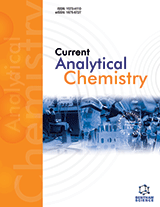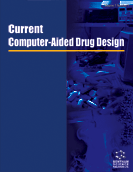摘要
结核病(TB)每年在全球造成数百万人死亡。结核分枝杆菌(Mtb)所采取的多种生存策略已经严重阻碍了现有的抗结核治疗方案,从而导致耐多药结核病(MDR)和耐药结核病(XDR)。目前抗生素对这些逆境的有效性稳步下降,表明其未来充足的补充几乎是不可能的,这将使社会陷入一场浩劫之中。过去多年来,研究人员一直在通过调整现有药物的性质或设计全新的药物来不断地产生新的抗结核药物。其中一种新兴的和成功的合成技术是分子杂交(MH),其涉及不同药效亚基的整合以形成具有被多种受体识别的新型原型。在大多数情况下,已报道所得缀合物相对于它们的母体分子表现出优越的生物活性分布,这归因于它们的不同或双重作用模式。因此,使用这种方法已经合成了几种新的有效的抗TB支架,并且在文献中被很好地引用。 在这次审查中,我们提供了一个总结的化学战略乐观的重点集中在通过MH方法开发新的结核分子装配。此外,系统地讨论了从不同的生物测定中揭示的结构活性关系。
关键词: 分子杂交,耐药性,结核,结核分枝杆菌,抗结核药物,结构活性的关系。
图形摘要
Current Medicinal Chemistry
Title:A Review of Recent Advancements in Anti-tubercular Molecular Hybrids
Volume: 24 Issue: 37
关键词: 分子杂交,耐药性,结核,结核分枝杆菌,抗结核药物,结构活性的关系。
摘要: Tuberculosis (TB) accounts for millions of deaths worldwide every year. Diverse survival strategies adopted by Mycobacterium tuberculosis (Mtb) have substantially hindered the existing anti-TB regimen thereby leading to multidrug-resistant (MDR) and extremely drug-resistant (XDR) strains of TB. The steady decrease in current antibiotics’ efficacy against these adversities is an indicator that their adequate replenishment in future is almost impossible, placing society on the precipice of a catastrophe. Over the past many years, researchers have been continuously generating new armamentarium of anti- TB drugs by tailoring the properties of available drugs or designing completely new agents. One of these emerging and successful synthetic techniques is molecular hybridization (MH) that involves the integration of different pharmacophoric subunits to form a new prototype with the ability to be recognized by multiple receptors. In most cases, the resultant conjugates have been reported to exhibit superior biological activity profiles relative to their parent molecules which is attributed to their different or dual modes of action. Accordingly, several new effective anti-TB scaffolds have been synthesized using this approach, and are well cited in literature.
In this review, we provide a summarized account of the chemical strategies optimistically focused to develop new molecular assemblies for TB via MH approaches. Additionally, the structure activity relationships revealed from different biological assays is systematically discussed.
Export Options
About this article
Cite this article as:
A Review of Recent Advancements in Anti-tubercular Molecular Hybrids, Current Medicinal Chemistry 2017; 24 (37) . https://dx.doi.org/10.2174/0929867324666170712164400
| DOI https://dx.doi.org/10.2174/0929867324666170712164400 |
Print ISSN 0929-8673 |
| Publisher Name Bentham Science Publisher |
Online ISSN 1875-533X |
 53
53 2
2 2
2 2
2
- Author Guidelines
- Bentham Author Support Services (BASS)
- Graphical Abstracts
- Fabricating and Stating False Information
- Research Misconduct
- Post Publication Discussions and Corrections
- Publishing Ethics and Rectitude
- Increase Visibility of Your Article
- Archiving Policies
- Peer Review Workflow
- Order Your Article Before Print
- Promote Your Article
- Manuscript Transfer Facility
- Editorial Policies
- Allegations from Whistleblowers
- Announcements
Related Articles
-
Novel 2-(2-Benzylidenehydrazinyl)Benzo[d]Thiazole as Potential Antitubercular Agents
Combinatorial Chemistry & High Throughput Screening Drug Metabolizing Enzymes and Transporters mRNA in Peripheral Blood Mononuclear Cells of Healthy Subjects: Biological Variations and Importance of Preanalytical Steps
Current Drug Metabolism Natural T Cell Immunity to Intracellular Pathogens and Nonpeptidic Immunoregulatory Drugs
Current Molecular Medicine Armed Imidazo [1,2-a] Pyrimidines (Pyridines): Evaluation of Antibacterial Activity
Letters in Drug Design & Discovery 1-R-2-([1,2,4]Triazolo[1,5-c]quinazoline-2-ylthio)etanon(ol)s: Synthesis, Bioluminescence Inhibition, Molecular Docking Studies, Antibacterial and Antifungal Activities
Current Computer-Aided Drug Design Benzocaine: Review on a Drug with Unfold Potential
Mini-Reviews in Medicinal Chemistry Hodgkin Lymphoma in HIV Positive Patients
Current HIV Research Comparison of HCV Core and CoreE1E2 Virus-Like Particles Generated by Stably Transfected Leishmania tarentolae for the Stimulation of Th1 Immune Responses in Mice
Current Drug Delivery Structure-Based Design of Inhibitors of the Crucial Cysteine Biosynthetic Pathway Enzyme O-Acetyl Serine Sulfhydrylase
Current Topics in Medicinal Chemistry Insights into sRNA Genes Regulated by Two-Component Systems in the <i>Bacillus cereus</i> Group
Current Bioinformatics Current Pharmaceutical Design of Antituberculosis Drugs: Future Perspectives
Current Pharmaceutical Design Bioactive Natural Products from the Antarctic and Arctic Organisms
Mini-Reviews in Medicinal Chemistry Synthesis and Structural Elucidation of Novel Benzothiazole Derivatives as Anti-tubercular Agents: In-silico Screening for Possible Target Identification
Medicinal Chemistry New Synthetic Antibiotics for the Treatment of Enterococcus and Campylobacter Infection
Current Topics in Medicinal Chemistry Recent Developments in Particulate-Based Vaccines
Recent Patents on Drug Delivery & Formulation Potential Drug Targets in Mycobacterial Cell Wall: Non-Lipid Perspective
Current Drug Discovery Technologies Clinical Profile of Mortality among Chronic Schizophrenic Patients: A Local Pilot Survey in Iran
Current Psychiatry Research and Reviews Ascaris lumbricoides: An Overview of Therapeutic Targets
Infectious Disorders - Drug Targets Novel Small-Molecule Inhibitors of Arylamine N-Acetyltransferases: Drug Discovery by High Throughput Screening
Combinatorial Chemistry & High Throughput Screening Unusual Food Allergy: AlioideaAllergic Reactions Overview
Recent Patents on Inflammation & Allergy Drug Discovery


























